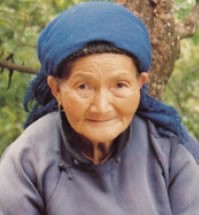The Min Bei, or Northern Min, are included as part of the Han Chinese nationality by the Chinese authorities.
The Jin Dynasty (AD 265-420): The Jin Dynasty was a period of conflict and disunity in China. The Western Jin capital of Luoyang fell to Xiongnu horsemen in AD 306. Xiongnu was a general name given to non-Chinese barbarians to the north and west - the forefathers of the present-day Turks and Mongols. This resulted in "150 years of bloodshed as competing non-Han tribes vied for absolute power." China was once again divided, and the tribes contained within its borders were at enmity.
The Han Chinese group expanded rapidly as it met other ethnic groups, conquered them culturally, and assimilated their populations into its own. One historian notes, "In 1500 BC there was no China, and there were no Chinese. The area that is now China was then inhabited by a great number of tribes with different cultures. Though the majority of them belonged to one or another branch of the Mongoloid race, other races were represented. There was no great man who created the first Chinese empire; it grew out of a long, slow process of assimilation and integration over centuries."
In ancient times the Chinese emperor offered annual sacrifices to Shang Di, the Heavenly Emperor. This has led some to believe the ancient Chinese worshiped the Creator God. The emperor recited: "Of old in the beginning, there was the great chaos, without form and dark. The five elements (planets) had not begun to evolve, nor the sun and moon to shine. In the midst thereof there existed neither form nor sound. You, O spiritual Sovereign, came forth in your presidency, and first did divide the grosser part from the purer. You made heaven; You made earth, You made man. All things with their reproducing power got their being."
When Marco Polo arrived in today's Fujian Province, he encountered many Christian communities along the coastal areas. The believers in Fuzhou asked Marco Polo's uncles for advice as to what they should do to gain freedom to worship. They told the Christians to contact the Nestorian Metropolitan in Beijing, "Explain to him your state, that he may come to know you and you may be able freely to keep your religion and rule."
The New Testament was translated into the Min Bei language in 1934. The JESUS Film is also available in Min Bei. Who will distribute these in their communities?
Pray for the Holy Spirit to call many from the Min Bei people to the Lord of lords.
Pray for the Lord to send and equip many workers from neighboring tribes to go to the Min Bei people.
Pray for Min Bei disciples to make more disciples.
Scripture Prayers for the Han Chinese, Min Bei in China.
Operation China, Asia Harvest, Copyrighted © Used with permission
| Profile Source: Joshua Project |












